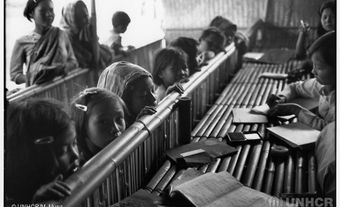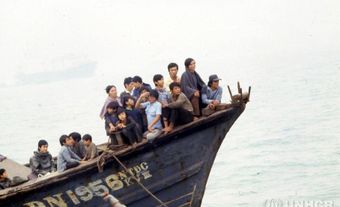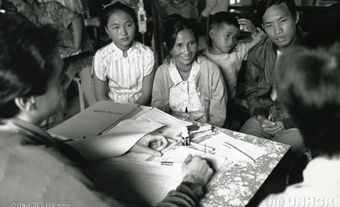Canadian society can be described, at one level, as a complex network of relations among ethnic groups which occupy unequal economic, political and social positions in Canadian society. Within this complexity 3 main axes of ethnic differentiation are identifiable: the relationship between Indigenous and non-Indigenous people, between English and French and between the colonizing (or "charter") groups and other immigrants and their descendants. These distinctions are relevant not only to the private experiences of individuals but also to public issues, eg, Indigenous rights and land claims; linguistic rights; immigration policy; prejudice and discrimination; and multiculturalism.
Although interrelated, these issues pertain to different matters largely because they concern different groups. For example, the controversy over language between English and French differs from that between other ethnolinguistic groups (eg, Ukrainians, Italians, Greeks) and the English-speaking or French-speaking communities because the official languages of Canada are English and French.
The relations among ethnic groups must be understood in terms of the access to and control of the society's resources and of the functioning of rules and practices that may benefit or disadvantage particular groups. Inequality among groups can result from several factors, including the circumstances of their arrival in Canada (eg, establishment of a colony by a European power; individual or family immigration); their size; their visibility; their internal economic, political and social organization; the direct or indirect support received from other groups or countries; and the power and status of the country of origin in the international order.
Groups who have achieved control over certain resources (eg, jobs, capital or institutional authority) will protect their gains and attempt to extend them. They are likely to try to deny access to power and control to other groups, and the institutional and bureaucratic barriers are designed to preclude or defuse attempts by such groups to bring about change. The relatively disadvantaged may indeed pressure for change in the economic or political situation, but their chances of success depend on the very factors which brought about inequality. As a result, improvements in the situation of disadvantaged minorities are frequently very slow (see Elites).
Indigenous Peoples and Canadian Society
The relationship between Indigenous peoples and the rest of Canadian society is characterized first by "marginality" and dependence. The historical settlement and expansion of English and French societies led to the displacement of the Indigenous population. Land was the main concern of the successive Indian Acts (see Indian) and of the treaties. Total control of Indigenous lands was given first to the Commission of Indian Lands in 1850 and then, through the British North America Act, to the federal government. Through treaties from 1850 to 1921 large tracts of land in central and western Canada were surrendered in exchange for reserve lands, money and promises of social assistance.
An objective of the Indian Act of 1876 and of its subsequent versions was the control and management of the Indigenous population. For this purpose, it defined "status Indians" as those registered in 1874, their closest dependants in the male line, and their wives and children. It also established a bureaucracy for the administration of Indigenous affairs which was staffed almost entirely by non-Indigenous people. Recently, this situation has begun to change: Indigenous people have been recruited in the government bureaucracy; the administration of Indigenous affairs has been decentralized; and moves in the direction of self-government have been undertaken, although progress in that direction is encountering considerable resistance, including from provincial governments.
The population of Indigenous ancestry also includes non-status Indians, Métis and Inuit. They do not have the special relationship that the status Indians have with the federal government. All, however, are affected by the dominant society's ideology of superiority and inferiority and tend to be located at the lower levels of the stratification system. The formation of Indigenous organizations, including pan-Indian national associations whose primary objective is the defence of Indigenous interests in land, may restore both objective and subjective equality to Indigenous peoples.
However, in their efforts at social, economic and political organization, native people will have to overcome the legacy of marginality and dependence. They will also have to transcend the numerous cleavages within the native population arising from different cultural and linguistic backgrounds, from the division of status Indians into some 592 bands, and the division of status from non-status Indians.
Francophone-Anglophone Relations
After the Conquest, the British progressively constructed a society parallel to the one that the French had already established. The institutions of the 2 subsocieties are critical for their respective members because they provide them with economic and political opportunities and because they embody their language, cultural values and traditions. As a result, the 2 groups have struggled, unequally, for the control of cultural, economic and political institutions.
The competition between the English and French societies has always been manifested in the struggle over the control of government institutions. The Quebec Act of 1774, the 1791 Constitutional Act, the Act of Union of 1841, the BNA Act and its modifications, the 1982 patriation of the Constitution and the Meech Lake Accord (see Meech Lake Accord Document) of 1987 have all been concerned with the distribution of powers and the symbolic recognition of the language and culture of both groups. The issues of job distribution, of control of economic institutions, of culture and of the size of their respective populations have been reflected in conflicts over policies dealing with matters such as immigration, international relations, industry and trade, education, family allowances, language of education and work, and mass communication.
Of course, issues change with time and circumstances, but the fundamental questions of political power, population size, access to capital for development, and of the cultural character of the society and its institutions will always be there as long as the 2 groups are in the same society. The competition is unequal, however, largely because of differences in population and wealth, and because of the Conquest and its implications, the British influence in the shaping of Canadian society and government institutions, and the anglophone character of North American society.
Immigrants and Canadian Society
The decrease in British representation led to a concomitant decrease in their control of the economy or of the political system or to a change in the status of Canada as a "white" society. Other European immigrants do not share equality with the charter groups. John Porter in The Vertical Mosaic argued that the crucial fact of Canadian life was the "exclusion of minority groups from the main loci of decision making within the corporate sector of the economy" (see Business Elites).
In politics the composition of federal Cabinets since 1867 has reflected only the struggle to balance English and French interests. The decision by certain groups, eg, Finns, Ukrainians and other central and eastern European immigrants, to become engaged in radical political activities has reflected their decision to challenge what has been called "the notion of Canadian society on the one hand and the existence of ethnic groups as something independent of the society on the other."
Conflicts between immigrant and charter groups are a result of unequal access to employment and education, and unequal security and social respect. Several groups have been the victims of systematic exploitation, discrimination and social exclusion, but their situation has largely improved as a result of their own individual and collective efforts, and because of legislation and economic prosperity.
For the first generation of immigrants the structure of social networks and organizations is formed largely for adaptive purposes, ie, to advance or defend shared interests and to provide social support. The structure tends to weaken in succeeding generations if the group has achieved some measure of economic advancement and assimilation.
At the individual level this manifests itself in the loss of language and culture and in a decreased participation in the group's associations and social networks. This does not mean a complete loss of identity and culture. However, what the second and subsequent generations retain as their lives evolve in Canada is a selection and transformation of what was brought from the country of origin.
Visible Minorities
The visibility of certain groups adds a dimension to the question of their full incorporation in Canadian society. Racism in Canada has been well documented in historical studies of immigration. Canadians manifest an ostrichlike approach to the problem, although studies reveal that prejudice and discrimination are a reality in Canada (see also Anti-Semitism; Black Canadians; Japanese Canadians; Chinese Canadians; Jewish Canadians). To the extent that negative attitudes and behaviour exist, it is more difficult for visible than for other minorities to avoid being subjected to them.
The Relationship of Ethnic Groups to Anglophone and Francophone Cultures
This relationship raises the question of how certain manifestations of individual and collective ethnicity (if they are to exist) are to be recognized and incorporated into Canadian society and how social institutions are to be modified to accommodate and recognize various cultural traditions.
The multiculturalism policies and programs of the various levels of government have been a step in that direction. But their aim has not been to restructure institutions to reflect the composition of the population. What such a restructuring would entail has by and large yet to be defined and whether or not it should be attempted remains a highly controversial question.

 Share on Facebook
Share on Facebook Share on X
Share on X Share by Email
Share by Email Share on Google Classroom
Share on Google Classroom


